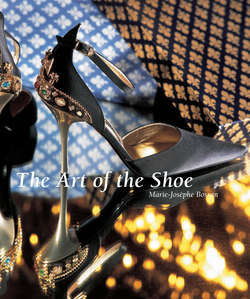Читать книгу The Art of the Shoe - Marie-Josèphe Bossan - Страница 17
На сайте Литреса книга снята с продажи.
From Antiquity up to our days
The Renaissance
ОглавлениеAt the end of the 15th century, poulaines fell victim to their own success and ended up popularized for common use. They were succeeded, without the slightest transition, by extremely wide, square-toe shoes designed for the fashion-conscious. As incongruous with fashion history as it may seem, this shoe was actually inspired by a congenital malformation: King Charles VIII had six toes on each foot, hence the very large toes of his custom-made shoes. The reaction against the previous fashion quickly went too far in the opposite direction. The Valois shoe worn during the reign of Louis XII (1462–1515) occasionally reached widths of thirty-three centimeters. The tip of the shoe, which was stuffed and decorated with animal horns, resembled a cow’s head, leading to nicknames such as mufle de vache (cow muzzle), pied d’ours (bear foot), and bec de cane (duck bill). The shoe’s eccentric form meant people had to straddle wide in order to walk, which naturally provoked sarcastic remarks.
During this same period, Venetians were wearing shoes called chopines, also known as mules échasses (mules on stilts) or pied de vach (cow feet). Attached to the foot with ribbons, these bizarre shoes displayed exaggerated platforms that could reach fifty-two centimeters high. The platforms themselves were of wood or cork and covered in velvet or richly decorated leather. Hidden under skirts, the shoes remained safe from scrutiny, but they resulted in a very comical walk. Hoisted upon such shoes, noblewomen had to support themselves between the shoulders of two servants in order to get around safely. This eccentric fashion certainly originated in Turkey, a country with which the Doges of the Republic traded. Turkish women were known to go to the bath on raised soles. Through the modified form of the chopine a Turkish harem shoe thus entered the palaces of Venetian aristocrats.
The wearing of chopines was banned in Spain by the archbishop of Talavera, who labeled women who wore them “depraved and dissolute.” The more tolerant Italian church, on the other hand, failed to blacklist the shoe. Quite contrarily, the church, in collusion with jealous husbands, saw a way to immobilize fickle wives at home, and thereby stymie illicit affairs. Although all the courts of Europe were taken with the chopine, the shoe was never more than a limited fashion. It nevertheless managed to reach England, where Shakespeare’s Hamlet says: “Your ladyship is nearer to heaven than when I saw you last by the altitude of a chopine” (Hamlet, Act II, Scene II).
The pantoufle, or mule, was a more moderate style imported from Italy that was first adopted in France in the early 16th century. Made of a thick cork sole without rear quarter, its lightness made it especially suitable for women to wear indoors.
From the reign of Francis I (1494–1547) to Henry III (1551–1589), men and women wore shoes called escarfignons. Also known as eschappins, these were flat slippers of satin or velvet with low-cut uppers and slashes. The horizontal and vertical slashes revealed the precious fabric of the stockings underneath. Rabelais (1494–1553) describes the shoes exactly in Gargantua, when he recounts the costumes of the Abbey of Thélème: “The shoes, slippers and mules of crimson, red, or purple velvet, resembled a jagged crayfish’s beard.” Like other articles of clothing during this period, shoes took after Germanic styles and were decorated with slashes called crevés. Nevertheless, the invention of the slashed shoe is credited to the soldiers of Francis I during the wars with Italy who, sustaining injuries from marching or from combat, had to adapt their shoes to fit their bandaged feet. As for protecting delicate shoes from filthy streets, wooden pattens remained popular for outdoor use.
Leonardo da Vinci is said to have invented the heel, but it did not appear until the end of the 16th century, when it began to rise, most likely in response to the flattering effect of greater height produced by the chopine. The first heels were attached to the sole by a piece of leather, as can be seen in the painting from the French School, entitled A Ball at the Valois Court (c.1582) in the Museum of Fine Arts, Rennes.
35. Chopine. Venice, 16th century. International Shoe Museum, Romans.
36. Wooden chopine covered in hide worn by the Venetians. Italy, 16th century. Height: 49 cm. Jacquemart Collection, depot of the National Museum of the Middle Ages, Thermal Baths of Cluny in Paris, International Shoe Museum, Romans.
37. Chopine having been worn. Venice, Italy, around 1600. Weissenfels Museum, with the authorization of Irmgard Sedler.
38. Man’s leather shoe. Around 1530–1540. Weissenfels Museum, with the authorization of Irmgard Sedler.
39. Woman’s shoe. Henri III period, France, 16th century. International Shoe Museum, Romans.
40. King Louis XI Seated on a Throne, Surrounded by the Knights of the Order of Saint Michael. 16th century, F° 9. The Hermitage Museum, Saint-Petersburg.
41. Paolo Caliari, known as Véronèse. The Meal at Simon’s House, detail, around 1570. Château de Versailles.
42. Anthony van Dyck. Portrait of Charles I, around 1635. Oil on canvas. 266 x 207 cm. Louvre Museum, Paris.
43. Frans Pourbus. Henri IV, 1610. Louvre Museum, Paris.
44. Gerritsz van Brekelenkan. A Gentleman Slipping on a Boot, Dutch School, 1655. International Shoe Museum, Romans.
45. Musketeer boot. France, 17th century.
